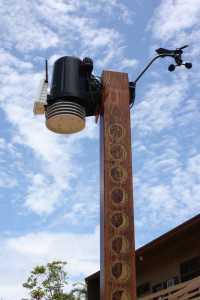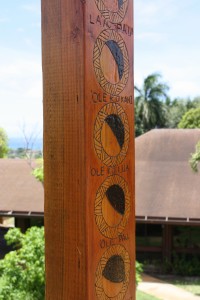
The weather station has 30 moon phases, from hilo to muku, from new moon to new moon, all carved by Tatiana Oje.
Photo: Hanul Seo/Kapiʻo
Kapiʻolani Community Colleges own student has designed a weather station behind Manele building. ASNS major, and student in the Summer Bridge program, Tatiana Oje, 25, has spent the last several months working on this Science, Technology, Engineering and Mathematics (STEM), and Mālama Hawaiʻi project.
The projects funding comes to the KapCC STEM program from Experimental Program to Stimulate Competitive Research (EPSCoR), which is a branch of the National Science Foundation (NSF).
Oje, who also installed the station, brought a cultural aspect to the weather station by adding the Hawaiian moon calendar and carvings, based off the research she’s been conducting. The first phase was the installation of the 8-foot weather station, and now, Oje is in the second phase of research, about Hawaiian wind names.
“(Research) is ongoing, and I’m trying to find new sources,” Oje said.
Oje is an artist, and wanted to incorporate some of her artwork in to the post, which lead her to her carvings.
The station has 30 moon phases, each carved in by Oje using a soldering iron from hilo to muku, or, new moon to new moon. There are 30 days in the Hawaiian moon calendar. At the top of the post, and a sensor measures the temperature and barometric pressure of the air.
The station receives weather variables, then the information is sent to interpreting software, which is then sent to a console in Manele.
“The goal is to get everything online and share our data with other institutions like NOAA (National Oceanic and Atmospheric Administration),” Oje said. “I hope to see it happen by either spring or fall.”
Eventually people from NOAA will come and evaluate the weather station, and if all goes well, then data collected will be posted to NOAAʻs website.
“The stem program at KCC is revolutionary,” Oje said. “I haven’t seen anything so student focused.”
Throughout the installation and research process, Bradley Hughes, mentor to Oje, and has worked for STEM for a year and a half now. Hughes also works in the garden behind Manele, helped provided cultural consulting to Oje.
Hughes shared that the weather station has been more than a science experiment, it’s cultural, and involves learning about the landscape in Hawaiʻi,
There were two weather stations that weren’t being utilized, according to Hughes, and Oje was doing Nā Hoʻokama a Pauahi, a Kamehameha Schools post-high school scholarship, and was looking for service learning hours.
As for why the Hawaiian mahina, or moon calendar was carved on to the weather station? The mahina was one of the best tools for reading weather. It would tell
Hawaiians when certain plants should be planted and so on, Hughes shared.
Hughes explained it was a, “something is happening at the right time at the right moment,” feeling.
This weather station is a way to create opportunities for students, keeping them intrigued.
“We can do small little projects here and there and encompass it into bigger projects that’ll benefit the students and school,” Hughes said.

